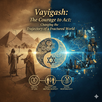A RESPONSE TO ANTI-SEMITISM: FOCUS ON THE 'WHY' NOT THE 'WHAT'
- Rabbi Yosef Vogel

- Mar 24, 2024
- 3 min read
Referred to as the oldest hatred, anti-Semitism possesses an aura of mystery while undeniably manifesting as a tangible force throughout history.
Its destructive influence is unparalleled, yet paradoxically, it has also served as a catalyst for significant historical events.
Despite its pervasive and enduring nature, there exists a notable lack of consensus regarding its precise definition. Even its designation sparks debate and contention.
This phenomenon stands as a cornerstone of much historical toxicity, implicating all of us as either participants or victims in its intricate dynamics.
In its most basic form, it is known simply as 'Jew hatred'.
Surprisingly, the Talmud offers profound insights into this enigmatic subject through a compelling parable.
“The actions of Ahasuerus and Haman (in the story of Purim) There were once two individuals, one of whom had a mound in the middle of his field and the other of whom had a ditch in the middle of his field, each one suffering from his own predicament.
The owner of the ditch, noticing the other’s mound of dirt, said to himself: Who will give me this mound of dirt, suitable for filling in my ditch; I would even be willing to pay for it with money, and the owner of the mound, noticing the other’s ditch, said to himself: Who will give me this ditch for money, so that I may use it to remove the mound of earth from my property?
One day, they happened to have met one another. The owner of the ditch said to the owner of the mound: Sell me your mound so I can fill in my ditch. The mound’s owner, anxious to rid himself of the excess dirt on his property, said to him: Take it for free; if only you had done so sooner.
Similarly, Ahasuerus himself wanted to destroy the Jews. As he was delighted that Haman had similar aspirations and was willing to do the job for him, consequently, he demanded no money from him”. (Megillah 14a)
The Rebbe's profound insights illuminate not only the 'what' of Jewish hatred but also its 'why', delving into the intricacies of human psychology and existential angst.
The parable the Rebbe offers unveils two fundamental aspects of anti-Semitic sentiment, which, though seemingly distinct, are interconnected.
At its core, the Jew is often viewed by Gentiles with suspicion or, at worst, varying degrees of animosity. Despite the non-Jew's desire for peaceful coexistence, there exists a pervasive perception of the Jew as enigmatic, possessing an elusive agenda that eludes comprehension. This perceived otherness breeds fear and, consequently, hatred—a sentiment fueled not by rationality but by ignorance and insecurity.
This manifestation of hatred is akin to the 'owner' agitated by the presence of a 'mound' in his field—an irritant he is eager to expunge.
However, beneath this surface layer lies a more profound dimension, one that delves into the existential quandary of the non-Jew. Observing the Jew, the non-Jew discerns a profound sense of purpose and connection to a higher narrative—an existence infused with deep meaning and a transcendence of the mundane. This realization engenders envy, as the non-Jew is confronted with his own existential vacuum in contrast.
Faced with this discomfort, the non-Jew is confronted with a choice: to seek spiritual fulfillment and address the void within or to eliminate the source of his unease—the Jew himself. This choice reflects the timeless adage: "If you dislike the message, kill the messenger".
Indeed, this metaphor unveils the deeper dynamics of envy, the underlying cause of the most intense and enduring forms of hatred. It is intense because it strikes at the core of one's being, and prolonged because acknowledging envy is a bitter pill to swallow.
Addressing anti-Semitism necessitates grappling with its underlying causes—a task essential for meaningful resolution and lasting peace.
Aligned with this insightful perspective, the Rebbe proposed a transformative approach to combat anti-Semitism. Drawing inspiration from the wisdom of Maimonides, he advocated for the dissemination of the code of universal values imparted at Mount Sinai—a beacon of light to dispel the darkness of hatred and ignorance.
By embracing and sharing these timeless principles of morality and ethics, humanity can collectively address the existential void that breeds animosity and division. In essence, filling this void with spiritual nourishment offers the pathway to genuine fulfillment and harmony.
This endeavor not only aligns with the prophetic vision of the Jewish people as "a light unto the nations" but also embodies their sacred responsibility to contribute positively to the world.
In today's era of unprecedented freedom, the Jewish people stand poised to seize this opportunity and lead by example. By championing universal values and fostering understanding and empathy, they can play a pivotal role in fostering a more inclusive and compassionate society for all.
Yosef Vogel




Comments